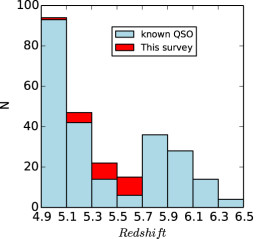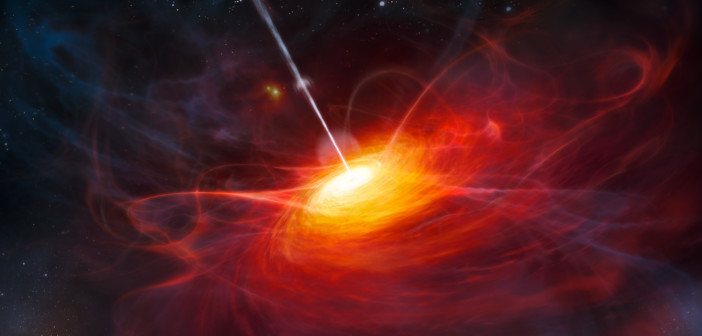Quasars — active and luminous galactic centers — can be difficult to find at some high redshifts due to their camouflaging color. A team of scientists has now come up with a way to detect these distant monsters in spite of their disguise.
Quasar Camouflage

The color track of quasars between 5 ≤ z ≤ 6 in the commonly used i – z and r – i bands. Each dot on the red line marks a 0.1 difference in redshift. The contours show the colors of M dwarfs, from early type to late type. Quasars at a redshift of 5.3 ≤ z ≤ 5.7 are clearly contaminated by M dwarfs, making them difficult to identify. [Adapted from Yang et al. 2017]
But quasars at this redshift are difficult to detect! The problem is contamination: quasars at this distance are the same color in commonly used optical bands as cool M-dwarf stars. As a result, surveys searching for quasars have often just cut out that entire section of the color space in order to avoid this contamination.
This means that there’s a huge gap in our sample of quasars around z ~ 5.5: of the more than 300,000 quasars known, only ~30 have been found in the redshift range of 5.3 ≤ z ≤ 5.7.

The addition of new color–color selection criteria using infrared bands (bottom two plots) allows the authors to differentiate quasars (blue) from M dwarfs (grey), which isn’t possible when only the traditional optical color–color selection criteria are used (top plot). [Adapted from Yang et al. 2017]
A New Approach
In a recent publication led by Jinyi Yang (Peking University, China and Steward Observatory, University of Arizona), a team of scientists has demonstrated a new technique for finding these missing quasars. The team uses this technique to perform the first systematic survey of luminous quasars at a redshift near z = 5.5.
Instead of relying only on the conventional color space in broad optical bands, Yang and collaborators selected candidates by also looking at their colors in near-infrared and mid-infrared bands. The team used observations from the Sloan Digital Sky Survey, the UKIRT Infrared Deep Sky Surveys — Large Area Survey, the VISTA Hemisphere Survey, and the Wide Field Survey Explorer.
Examining the quasar candidates in these color spaces allowed the authors to more clearly differentiate between the M dwarfs and the quasars, so that they could select only the candidates that clearly fell in the regions dominated by quasars in all three spaces. Yang and collaborators then performed spectroscopic follow-up on their candidates to confirm them.
Gap Quasars Uncovered

The authors found 21 new high-redshift quasars (red), including 15 in the range of 5.3 ≤ z ≤ 5.7. [Adapted from Yang et al. 2017]
This initial success has more applications in the future; upcoming surveys will provide an even larger sample to examine for z ~ 5.5 quasars. The team demonstrated that their pipeline can be applied to such surveys by testing it on some preliminary data from the UKIRT Hemisphere Survey. In just this initial test they already discovered another z ~ 5.5 quasar, demonstrating that they’ll have little difficulty finding more once the complete data set is released.
Citation
Jinyi Yang et al 2017 AJ 153 184. doi:10.3847/1538-3881/aa6577


1 Comment
Pingback: filling in a quasar sampling gap